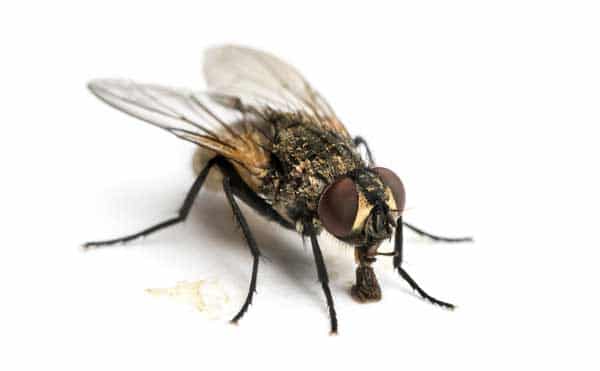FLIES
EXTERMINATOR
FLIES EXPERTS
Drosophila melanogaster, or housefly, is the best-known and most common species of Drosophila found in homes. This small brownish-yellow fly is about 3 or 4 mm long, wings included. The head carries a pair of short antennae whose end is feathery. The compound eyes are bright red. To the thorax are attached two large oval wings, which the insect holds crossed on its abdomen when it does not fly. The abdomen is rather short and striped with dark bands. Its end is dark and rounded in the male, and lighter and pointed in the female. The male is also distinguished by its smaller size and by the presence of “sexual combs” on its front legs. The function of these appendages is unknown (they may play a role in courtship).
Contact our experts now!

DO NOT WAIT
MORE!
CONTACT US
NOW
FOR YOUR
EXTERMINATOR.
PLAN A
VISIT
TODAY
WE RESPOND TO
FREQUENTLY ASKED QUESTIONS
ON THE FISHES
ALL ABOUT FLIES
Why do I have so many flies in my house?
There are many reasons why you may have a lot of flies in your home. Here are some of the most common ones:
- Accessible food: Flies are attracted to food, especially rotting fruit, pet food and uncovered food. It is therefore important to keep food covered and not to let fruit rot.
- Garbage: Uncovered or poorly maintained garbage cans can attract flies. Make sure your garbage cans are securely closed and cleaned regularly.
- Decaying plants: If you have decaying plants in or near your home, they can attract flies. It is advisable to remove or maintain them regularly.
- Accessible entrances: Flies can enter your home through open windows, unsealed doors or cracks in walls and window frames. Make sure these areas are well sealed.
- Stagnant water: Flies are attracted to stagnant water for breeding. Check for standing water in or around your home, such as clogged gutters, containers with water, or wet areas.
To get rid of flies, you can use fly traps, insecticides or natural methods like repellent plants. If the infestation is significant, it may be necessary to call in a professional.
How to get rid of flies inside a house?
There are several methods to get rid of flies inside the house:
- Fly traps: These devices contain attractive substances that attract flies and trap them inside. You can buy them at garden supply stores or make them yourself at home.
- Insecticides: You can use insecticides specifically designed to kill flies. However, use these products with caution, as they can be harmful to human health and the environment if used excessively.
- Natural methods: There are many natural methods to keep flies away. For example, certain plants, such as lavender, basil and lemongrass, are known to repel flies. You can also make a fly trap using apple cider vinegar.
- Eliminate sources of attraction: Eliminate potential sources of attraction for flies, such as open food, garbage cans and standing water.
- Maintain cleanliness: A clean house is less likely to attract flies. Be sure to clean up after meals, don’t leave food uncovered, and empty the garbage regularly.
- Call in a professional: If the fly infestation is very serious and you are unable to control it yourself, it may be necessary to call in a professional exterminator.
Where do flies lay in houses?
In a house, flies look for warm, moist and dark places to lay their eggs. Here are some typical places:
- Garbage cans: Flies are attracted to organic waste and rotting food that may be found in garbage cans. They lay their eggs, which will become larvae feeding on this waste.
- Open food: If you leave food uncovered, especially rotting fruits and vegetables, flies can lay their eggs in them.
- Pet Litter: Flies are attracted to feces, including those of pets.
- Drains and sinks: Flies can lay their eggs in food scraps and dirt that can accumulate in sink and shower pipes.
- Potted plants: If the soil of potted plants is too wet and contains decaying organic matter, it can also attract flies.
To prevent flies from laying eggs in your home, it is important to keep these areas as clean and dry as possible.
How do you know if there is a fly nest?
Flies do not have nests in the traditional sense of the word, as do birds for example. However, they choose specific sites to lay their eggs, which can sometimes be considered “nests”. To determine if you have such a site in your home, here are some signs to look for:
- Presence of adult flies: If you observe a large number of adult flies in a certain area of your home, they may have laid their eggs nearby.
- Presence of larvae: Fly larvae, also called maggots, are small white worms that you may find in areas where flies have laid their eggs. Garbage cans, rotting food, drains and pet litter are common egg-laying sites.
- Presence of maggots or pupae: Maggots develop into pupae before becoming adult flies. Pupae are small dark cocoons that can be found in the same areas as the larvae.
- Flies that consistently land on a specific surface: If you notice that flies are particularly attracted to a certain area, they may have laid their eggs there.
The key to getting rid of fly-laying sites is to keep your home clean, especially by removing trash quickly and avoiding leaving food out in the open.

| Name | FLIES |
|---|---|
| Class | Insects |
| French name | Flies |
| Latin name | Musca |
| Length | 5 to 8 mm |
| Colour | Brown and/or black |
| Life | 40 to 85 days |
MORE INFORMATION ON FLIES
LIFE CYCLE OF FLIES
Drosophila is an insect with complete metamorphosis or holometabolous. The female lays a few hundred elongated and whitish eggs, difficult to see with the naked eye. It deposits them on fermenting fruit or other wet materials. Each egg has two short breathing tubes that emerge from the liquid in which it was laid. The female produces 25 to 35 eggs per day. The hatching takes place 30 hours after the laying and gives life to a white maggot.
The small larva is whitish and has no legs. The end of its body corresponding to the head is more pointed than the other. It moves actively on wet surfaces where it feeds. Drosophila lives as a larva for about five or six days. It moults twice during this period. In the third larval stage, it moves to a drier environment to transform into a pupa inside its last larval skin. Its cuticle hardens and becomes darker, taking on a brownish or orange hue. The nymph carries a pair of filaments at the front of the body.
After about five days, the adult Drosophila emerges from the pupal shell. Flies are ready to mate soon after they appear and may do so more than once. When courting, the male produces a sound by vibrating his wings. If the female is receptive, she responds favourably to this love song. The female can store sperm from insemination and use it to lay eggs for several days. Adult Drosophila can live for several weeks.
These flies reproduce throughout the year in heated homes. The length of its life cycle varies according to the temperature: it is 50 days at 12°C and only 8 days at 30°C.
HABITAT
Drosophila is often observed in the vicinity of spoiled fruit and decaying wet plant material. It is common near ponds and marshes, as well as in houses. It is usually found where there is decaying or fermenting organic matter (dead aminal). But houses, litter boxes and food dishes can attract flies.
POWER SUPPLY
Adults feed on ripe or spoiled fruit (fruit fly), decaying plants and fungi, and fermented liquids (beer, wine, cider, vinegar). They also feed on nectar and other sweet solutions. The larvae develop on a variety of sweet or fermented materials, usually of plant origin, which produces ethers and esters. This favours the growth of the yeast on which the larvae feed.
CONTROL METHODS & PEST MANAGEMENT
The high reproductive power of Drosophila makes it an ideal laboratory animal. But this characteristic is less appreciated when the species multiply happily in homes, restaurants, hospitals, fruit and vegetable markets, canneries, grocery stores, food processing plants, warehouses, breweries, etc. However, these small flies are generally not very problematic.
Drosophila is often introduced into homes as eggs laid on fruit. A few bananas ripening on a kitchen counter can be the source of an infestation. It is often enough to get rid of these fruits to avoid the proliferation of insects.
These flies are attracted to any fermenting substance. Examples of what may entice them in and around the house include ripe fruits and vegetables (especially bananas, pineapples, tomatoes, and potatoes), fermented liquids (wine, cider, vinegar, beer), juices, ketchup, sour milk, damp mops and wet rags, garbage cans and other dirty waste containers, and poorly draining sinks and drains (a thin layer of organic debris can build up). These flies are also often seen near windows and sinks, as the light and humidity attract them.
To control drosophila infestations, it is necessary to eliminate access to their food sources and breeding sites and to keep them out. Keep intruders out by installing screens on doors and windows, or change the ones you have for finer mesh ones. Also, avoid keeping doors open. In your efforts to eliminate drosophila, remember that they need decaying matter and moisture to thrive. It doesn’t take much (a piece of fruit that has fallen under a piece of furniture or a bottle that has not been rinsed properly), so be careful! If the infestation is large, there are probably several egg-laying sites in the house. Good housekeeping is the key to effective control.
- Sweep or vacuum floors and carpets regularly.
- Rinse out cans of juice and other sweet foods, milk containers, ketchup, alcohol and soft drink bottles before putting them in the garbage or recycling bin.
- Clean up leftover food quickly when preparing meals.
- Carefully mop up any spilled alcohol, juice, milk or other liquids, even under the refrigerator or stove.
- Dry floors and sinks after washing, and dry damp cloths and mops thoroughly, outdoors if possible.
- Do not leave food out in the open, such as on a counter or in a cupboard.
- Clean sinks and drains regularly. If necessary, use a stiff brush or sterilize them with boiling water.
- Wash walls and other surfaces where food deposits may be present (near the stove, for example).
- Place food waste in closed containers. Place a plastic bag in the garbage can and scrub it thoroughly regularly.
- If you are making beer or wine, be sure to clean your equipment after use.
- In restaurants and other commercial food premises, keep an eye on produce crates, peeling equipment, industrial dishwashers, floor drains, wet cloths and mops, the trash compactor and garbage cans. Drosophila often breeds in outdoor waste containers and then enter through doors and windows.
To capture the adults, make a homemade trap using a glass or clear plastic jar of about one litre. Place a piece of ripe banana sprinkled with yeast as bait. Attach a paper or plastic funnel to the opening of the jar with the smaller end pointing to the bottom. Flies will descend into the funnel to access the food and will be trapped. Then simply kill them by placing the closed container in the sun or freezer for a few days, or by running soapy water through the funnel if it is plastic. Plug the pot to prevent flies from flying away. Re-bait the trap as needed, and place more than one if the infestation is large. There are also commercial traps for drosophila, as well as various insecticides. If you choose a chemical insecticide, ask a specialist to choose the least toxic product best suited to your situation. Follow the manufacturer’s instructions carefully, proceed with caution and remember that most chemical insecticides can be harmful to you and the environment.
Ready to get rid of invasive flies? Contact our experts today! No more fly swatters, our exterminators will find the source and get rid of the flies for good!

